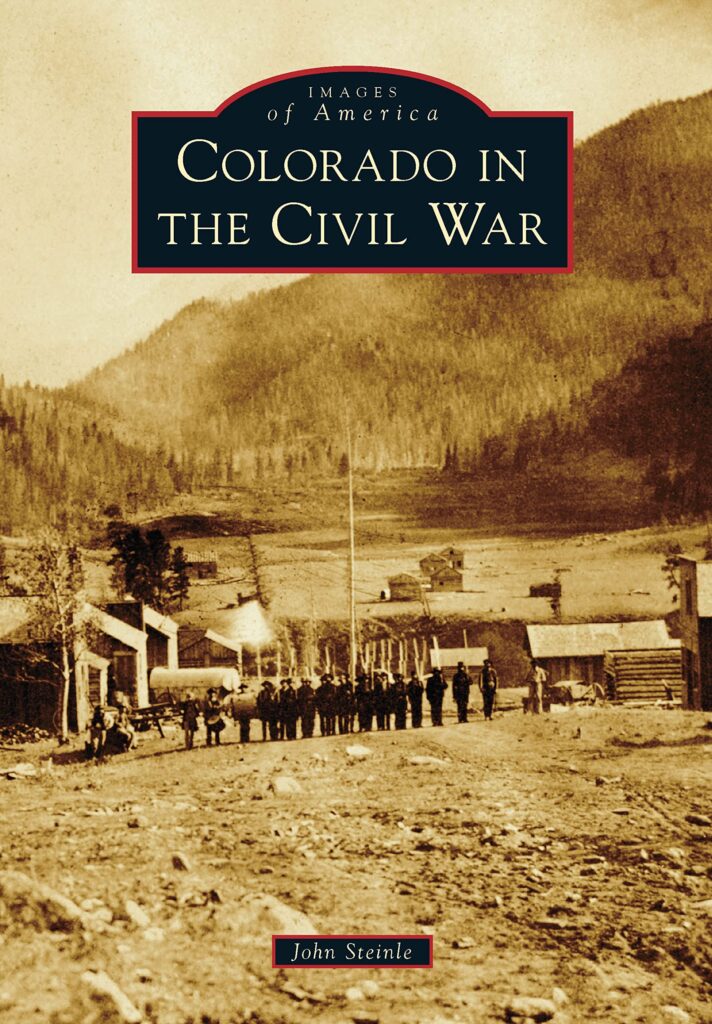By John Steinle.
Charleston, SC: Arcadia Publishing, 2023.
ISBN 978-1-4671-0971-0. Photographs. Maps. Bibliography. Index.
Pp. vi, 127. $23.99.
In this easy-to-read, succinct, and informative overview of Colorado’s involvement in the Civil War, author John Steinle provides a valuable resource for anyone looking to broaden their understanding of this pivotal time in American history. Part of Arcadia Publishing’s Images of America series, Colorado in the Civil War provides a plethora of historical photographs that help bring the fascinating characters and stories to life, taking the reader on a journey not unlike walking through a Colorado Civil War museum. This volume is worth adding to one’s Civil War collection and can benefit researchers, teachers, students, and history buffs alike.
Steinle’s book focuses on the pre-Civil War gold rush, Colorado volunteer units, key battles, the state’s economy, and the roles played by Native American tribes. It covers relatively minor battles when compared to the main engagements in the Eastern Theater, but it demonstrates the role of the Army in securing the American frontier for the Union. It also includes numerous details that typical Civil War volumes are unlikely to examine.
Each of the nine chapters begins with a one-page overview. Following this, multiple pages with related pictures elaborate on the subject area. The photographs include soldiers, civilians, Native Americans, maps, buildings, and weapons. Each picture is accompanied by an explanation of its significance, and some of the captions include additional details not included in the chapter overview. For example, one commentary explains that it was soldiers of the 3d Colorado Volunteer Cavalry who tied five members of the Reynolds Gang to trees and executed them in 1864.
Two beneficial things Steinle could have added are a clear reference map of the West in the front of the book, identifying the 1861 states, territories, routes of travel, and forts, and a second map of Colorado showing the main towns, Native American villages, mining locations, travel routes, and sites of key events. These visuals would help orient the reader to the geographic context of the information provided in the book.
Steinle covers a number of notable events, including the attempt by Coloradans loyal to the Confederacy to form a Rebel unit at Mace’s Hole in 1861. Union troops from Fort Garland thwarted this effort. The following year, Colorado units engaged a Confederate force from Texas near Valverde, New Mexico. The soldiers fought alongside the legendary Colonel Christopher “Kit” Carson, who commanded the 1st New Mexico Volunteer Infantry.
Colorado forces also played a key role at Glorieta Pass, called the “Gettysburg of the West,” where Major John Chivington led 488 men to surprise and destroy the Confederate supply train, forcing a Confederate retreat to Texas. Two years later, Chivington also commanded forces during the Sand Creek Massacre, where the 1st and 3d Colorado Volunteer Cavalry Regiments fought alongside the 1st New Mexico Infantry. The killing of Native American women and children ignited years of violence. In the 1990s, Senator Ben Nighthorse Campbell led efforts to make the Sand Creek location a National Historic Site.
Colorado troops also served in Kansas, Missouri, and Indian Territory (present-day Oklahoma). In 1863, a mounted detachment from the 2d Colorado Volunteer Infantry attacked William Quantrill’s guerrillas after they raided Lawrence, Kansas. In Indian Territory, Colorado soldiers fought alongside the 1st Kansas Colored Volunteer Infantry. In 1864, the 2d Colorado Volunteer Cavalry, serving in Missouri, helped oppose an invasion by 12,000 Confederate troops and 5,000 guerrillas. The Colorado forces engaged in delaying actions and suffered heavy casualties at Newtonia.
Overall, Steinle presents a well-researched and organized presentation of Colorado’s involvement in the Civil War, accompanied by a fascinating array of historical photographs. Readers will likely find a wealth of new information, and researchers might find a topic for further study. Even though it was not yet a state, Steinle’s work dispels the myth that Colorado did not play a meaningful role in the Civil War.
Commander Jeff Prickitt, USNR
Parkville, Missouri
